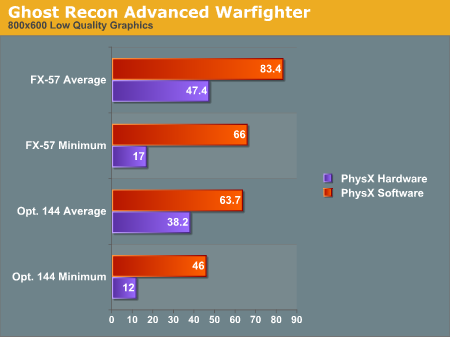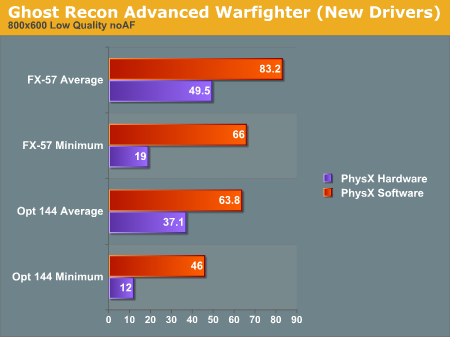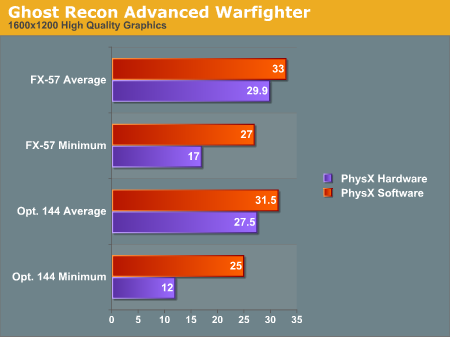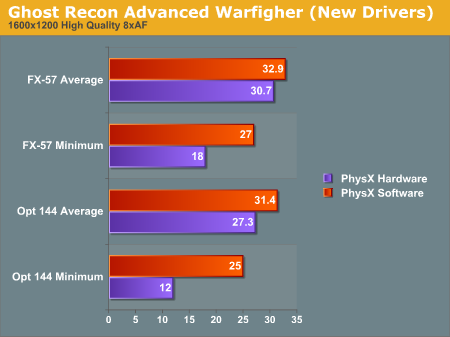Ghost Recon Advanced Warfighter Tests
And the short story is that the patch released by AGEIA when we published our previous story didn't really do much to fix the performance issues. We did see an increase in framerate from our previous tests, but the results are less impressive than we were hoping to see (especially with regard to the extremely low minimum framerate).Here are the results from our initial test, as well as the updated results we collected:




There is a difference, but it isn't huge. We are quite impressed with the fact that AGEIA was able to release a driver so quickly after performance issues were made known, but we would like to see better results than this. Perhaps AGEIA will have another trick up their sleeves in the future as well.
Whatever the case, after further testing, it appears our initial assumptions are proving more and more correct, at least with the current generation of PhysX games. There is a bottleneck in the system somewhere near and dear to the PPU. Whether this bottleneck is in the game code, the AGEIA driver, the PCI bus, or on the PhysX card itself, we just can't say at this point. The fact that a driver release did improve the framerates a little implies that at least some of the bottleneck is in the driver. The implementation in GRAW is quite questionable, and a game update could help to improve performance if this is the case.
Our working theory is that there is a good amount of overhead associated with initiating activity on the PhysX hardware. This idea is backed up by a few observations we have made. Firstly, the slow down occurs right as particle systems or objects are created in the game. After the creation of the PhysX accelerated objects, framerates seem to smooth out. The demos we have which use the PhysX hardware for everything physics related don't seem to suffer the same problem when blowing things up (as we will demonstrate shortly).
We don't know enough at this point about either the implementation of the PhysX hardware or the games that use it to be able to say what would help speed things up. It is quite clear that there is a whole lot of breathing room for developers to use. Both the CellFactor demo (now downloadable) and the UnrealEngine 3 demo Hangar of Doom show this fact quite clearly.










67 Comments
View All Comments
AndreasM - Wednesday, May 17, 2006 - link
In http://www.xtremesystems.org/forums/showthread.php...">some cases the PPU does increase performance. The next version of Ageia's SDK (ETA July) is supposed to support all physics effects in software, ATM liquid and cloth effects are hardware only; which is why some games like Cellfactor can't really run in software mode properly (yet). Hopefully Immersion releases a new version of their demo with official software support after Ageia releases their 2.4 SDK.UberL33tJarad - Wednesday, May 17, 2006 - link
How come there's never a direct comparison between CPU and PPU using the same physics? Making the PPU do 3x the work and not losing 3x performance doesn't seem so bad. It puts the card in a bad light because 90% of the people who will read this article will skip the text and go straight for the graphs. I know it can't be done in GRAW without different sets of physics (Havok for everything then Ageia for explosions) why not use the same Max Physics Debris Count?Genx87 - Wednesday, May 17, 2006 - link
I am still in contention it is a GPU limitation of having to render the higher amount of objects.One way to test this is to setup identical systems but one with SLI and the other with a single GPU.
1. Test the difference between the two systems without physics applied so we get an idea of how much the game scales.
2. Then test using identical setups using hardware physics and note if we see any difference. My theory is the amount of objects that need to be rendered is killing the GPU's.
There is definately a bottleneck and it would be agreat if an article really tried to get to the bottom of it. Is it CPU, PPU or GPU? It doesnt appear that CPU is "that" big an issue as the difference between the FX57 and Opty 144 isnt that big.
UberL33tJarad - Wednesday, May 17, 2006 - link
Well that's why I would be very intersted if some benchmarks could come out of http://pp.kpnet.fi/andreasm/physx/">this demo. The low res and lack of effects and textures makes it a great example to test CPUvsPPU strain. One guy said he went from http://www.xtremesystems.org/forums/showpost.php?p..."><5fps to 20fps, which is phenomenal.You can run the test in software or hardware mode and has 3k objects interacting with each other.
Also, if you want to REALLY strain a system, try http://www.novodex.com/rocket/NovodexRocket_V1_1.e...">this demo. Some guy on XS tried a 3ghz Conroe and got <3fps.
DigitalFreak - Wednesday, May 17, 2006 - link
Good idea.maevinj - Wednesday, May 17, 2006 - link
"then it is defeating its won purpose"should be one
JarredWalton - Wednesday, May 17, 2006 - link
Actually, I think it was supposed to be "own", but I reworded it anyway. Thanks.Nighteye2 - Wednesday, May 17, 2006 - link
2 things:I'd like to see a comparison done with equal level of physics, even if it's the low level of physics. Such a comparison could be informative about the bottlenecks. In CoV you can set the number of particles - do tests at 200 and 400 without the physx card, and tests at 400, 800 and 1500 with the physx card. Show how the physics scale with and without the physx card.
Secondly, do those slowdowns also occur in Cellfactor and UT2007 when objects are created? It seems to me like the slowdown is caused by suddenly having to route part of the data over the PPU, instead of using the PPU for object locations all the time.
DerekWilson - Wednesday, May 17, 2006 - link
The real issue here is that the type of debris is different. Lowering number on the physx cards still gives me things like packing peanuts, while software never does.It is still an apples to oranges comparison. But I will play around with this.
darkdemyze - Wednesday, May 17, 2006 - link
Seems there is a lot of "theory" and "ideal advantages" surrounding this card.Just as the chicken-egg comparison states, it's going to be a tough battle for AGEIA to get this new product going with lack of support from developers. I seriuosly doubt many people, even the ones who have the money, will want a product they don't get anything out of besides a few extra boxes flying through the air or a couple of extra grenade shards coming out of the explosion when there is such a decrament in performance.
At any rate, seems like just one more hardware component to buy for gamers. Meh.